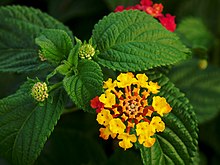Lantana
From Wikipedia, the free encyclopedia
For other uses, see Lantana (disambiguation).
| This article needs additional citations for verification. (December 2007) |
| Lantana | |
|---|---|
 |
|
| Wild-type Spanish Flag (Lantana camara) | |
| Scientific classification | |
| Kingdom: | Plantae |
| (unranked): | Angiosperms |
| (unranked): | Eudicots |
| (unranked): | Asterids |
| Order: | Lamiales |
| Family: | Verbenaceae |
| Genus: | Lantana L. |
| Type species | |
| Lantana camara L.[1] | |
| Species | |
|
About 150, see text |
|
Lantana's aromatic flower clusters (called umbels) are a mix of red, orange, yellow, or blue and white florets. Other colors exist as new varieties are being selected. The flowers typically change color as they mature, resulting in inflorescences that are two- or three-colored.
"Wild lantanas" are plants of the unrelated genus Abronia, usually called "sand-verbenas".
Ecology

Lantana overgrowing an abandoned plantation in Sdei Hemed, Israel
The spread of lantana is aided by the characteristic of their leaves, which are somewhat poisonous to most animals, while their fruit is a delicacy for many birds which distribute the seeds. Birds like the Yellow-fronted White-eye of Vanuatu, the Superb Fairy-wren in Australia, the Scaly-breasted Munia, or the Mauritius Bulbul in the Mascarenes thus unwittingly contribute to the degradation of their home ecosystem.[citation needed]
Biological control of introduced lantanas has been attempted, without robust success. In Australia, about 30 insects have been introduced in an attempt to control the spread of lantanas, and this has caused problems of its own. The Lantana Bug (Aconophora compressa) for example is a polyphagous species introduced in 1995 that feeds on dozens of plants, and not only has it failed to have a noticeable impact on the lantana population, it has even become a pest in horticulture, parasitizing the related fiddlewoods (Citharexylum). The small Lantana-feeding moths Epinotia lantana and Lantanophaga pusillidactyla, while not becoming pests, have nonetheless failed to stem the spread of the invasive weed, as has the Lantana Scrub-hairstreak butterfly (Strymon bazochii) which was introduced to control lantanas on the Hawaiian Islands.
Other Lepidoptera whose caterpillars feed on Lantana species include the Common Splendid Ghost Moth (Aenetus ligniveren), Aenetus scotti, Endoclita malabaricus, Hypercompe orsa and the Setaceous Hebrew Character (Xestia c-nigrum). The Swamp Wallaby (Wallabia bicolor) is one of the few mammals that eat Lantana leaves without apparent ill effect.
As a positive aspect, lantanas are useful as honey plants, and Spanish Flag (L. camara), L. lilacina and L. trifolia are sometimes planted for this purpose, or in butterfly gardening. Butterflies which are attracted to lantana flowers are most notably Papilioninae (swallowtail and birdwing butterflies). Hesperiidae (skippers) and certain brush-footed butterflies (namely Danainae and Heliconiinae), as well as some Pieridae (e.g. Cloudless Sulphur, Phoebis sennae) and Lycaenidae (e.g. the aforementioned Lantana Scrub-hairstreak), also like to visit the plants' flowers. Consequently, as total eradication of Lantana seems often impossible, it may in many cases be better to simply remove plants with immature (green) fruit to prevent them from spreading.
Some weaverbirds, e.g. the Black-throated Weaver (Ploceus benghalensis) and the Streaked Weaver (P. manyar), highly value Lantana flowers for decorating their nests. An ability to procure spectacular and innovative decorations appears to be desired by females, and consequently is an indicator of the males' fitness.
Ceratobasidium cornigerum is a higher fungus which parasitizes Lantana among other plants. The Sweet Potato Whitefly (Bemisia tabaci) is a common greenhouse pest and is often distributed with infested lantanas.
Lantana species, especially L. camara,[3] contain pentacyclic triterpenoids that cause hepatotoxicity and photosensitivity when ingested by grazing animals such as sheep, goats, bovines,[4] and horses.[5] This has led to widespread livestock loss in the United States, South Africa, India, Mexico, and Australia.[4]
Uses
Lantana species are widely cultivated for their flowers in tropical and subtropical environments and (as an annual plant) in temperate climates.Most of the plants sold as lantana are either Spanish Flag (species of section Lantana and their hybrids, including L. camara, L. depressa, L. hirsuta, L. horrida, L. splendens, L. strigocamara, etc.), or Trailing Lantana (L. montevidensis).[6] Numerous cultivars of the Spanish Flag exist, including 'Irene', 'Christine' and 'Dallas Red' (all tall-growing cultivars) and several recently introduced shorter ones. The shorter cultivars may flower more prolifically than the taller ones. L. montevidensis gives blue (or white) flowers all year round. Its foliage is dark green and has a distinct odor.
Although lantanas are generally hardy and, being somewhat toxic, are usually rejected by herbivores, they may still become infested with pests.
The edibility of Lantana berries is contested. Some experts claim Lantana berries are edible when ripe[7] though like many fruit are mildly poisonous if eaten while still green. Other experts claim that experimental research indicates that both unripe and ripe Lantana berries are potentially lethal, despite claims by others that ripe berries are not poisonous.[8]
Extracts of Lantana camara may be used for protection of cabbage against the aphid Lipaphis erysimi.[9]
Selected species
|
|
Formerly placed here
- Cordia linnaei Stearn (as L. corymbosa L.)
- Buddleja salviifolia (L.) Lam. (as L. salviifolia L.)[11]

Tidak ada komentar:
Posting Komentar